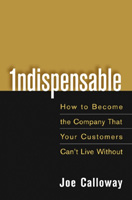 |
| ||||||||||||||||

|
Indispensable: How To Become The Company That Your Customers Can't Live Without Joe Calloway
Excerpt from Indispensable: How To Become The Company That Your Customers Can't Live Without From The Preface From the television viewer who would always tape rather than miss a single episode of HBO's "Sex And The City," to the corporate buyer who will choose a trusted vendor over a lower priced competitor, there are customers who consider certain products or companies indispensable. It's the mother lode.the jackpot.the Holy Grail of business: loyal customers who want to do business with you, and only you, when buying your product or service. Think of a company that you wouldn't want to live without. We all have at least one. It might be your overnight shipping provider; an auto repair shop; or the internet company that provides your office supplies. What's their secret to winning your business and continuing loyalty? How do they do it? And, most important, what are they doing that you should be doing with your own customers? Indispensable companies are the ones that win the bid even though a competitor came in with a lower price. They are the ones we'll drive out of our way to patronize even though we could buy the same product at a more convenient location. And they are most often the companies that have created the most profitable relationships with customers. So how do you become indispensable? What's the secret to becoming the company that your customers can't live without? That's what this book is about. It's a study of the factors that make a company a complete, total, absolute necessity to its customers. Identifying the factors is actually pretty easy. Implementation and execution tend to be a bit tougher. As the old saying goes, "Ideas are funny things. They don't work unless we do." Becoming indispensable means becoming the default choice. When a customer needs what you sell, she chooses you automatically, almost without thought. You become a habit. The idea is to be a customer magnet, pulling business past your competition and right into your door, or catalog, or website Indispensable companies have a clear sense of focus on where they "fit" in the grand scheme of the marketplace. It begins with a few simple, vitally important questions:
Most people are interested in practical application rather than theory, so this book is heavy on real world examples. The case studies of indispensable companies range from a check printer in a shrinking market that is reinventing itself through a remarkable collaborative process with customers; a hotel chain that locks in customer loyalty with a unique and compelling experience; a restaurant whose customers line up around the block to partake of a magic blend of pancakes and personality; a seminar company that provides continuing education to attorneys - delivered with a "concierge" philosophy; a bank that built, from scratch, a model of how to transcend commodity in the highly competitive financial services industry; and a sales consultant/trainer/speaker/writer who has created raving fans by creating value, then giving it away. While every company I studied achieved success in its own unique way, there were five factors that they all had in common. I call these factors The Five Drivers:
One point that is made throughout the book is that becoming indispensable requires creativity. There is no template for success, nor is there a fill-in-the-blanks ten-step guide or a color-by-numbers picture-painting approach to success. It's not that easy. You have to figure it out. Take the incredibly powerful strategy of creating community among your customers. Creating community is a strategy that has been used to great advantage by indispensable entities ranging from Apple's iPod, to the rock band Los Lobos. Becoming the common bond among a group of customers takes you to a whole new level of prominence, and it's a lesson that any business can put to good use. It requires, however, the creative vision to look at how other companies have tapped the powerful marketing force of creating community and figuring out your version of it. This isn't about copying what another company has done. It's about letting examples of innovation in a wide range of businesses serve as a catalyst for your own imagination. Perhaps the most striking lesson I learned in researching indispensable companies is that they have a firm grasp on some seemingly obvious but often overlooked factors in business. Some of these get into "Duh!" territory, like the incredible power of a first impression, or telling customers the truth, or that doing your job and delivering what the customer is paying for does NOT equal exceeding anybody's expectations. It's often been said that success comes from being at the right place at the right time, and I wholeheartedly agree. In fact, indispensable companies make it an integral part of their strategy to be at the right place at the right time as often as possible. It's much more than physical location or having a great web site. Being accessible to customers and giving them what they want, they way they want it, when they want it, is a matter of design, not luck. It's also a matter of every employee having a constant, unwavering focus on the customer. Of The Five Drivers, perhaps the most powerful is the idea of Big Picture Outcome. It's so important that it gets its own chapter in the book. Mediocre companies are transaction focused. Indispensable companies, and everyone in them, are focused on creating outcomes for their customers. It's a matter of every employee being fully present in the sense of total engagement far beyond the immediate delivery of a product or service. Big Picture Outcome requires that you embrace a customer-centric philosophy that drives everything you do. You may have wondered why every company, even the really bad ones, seems to be able to come up with a gloriously written mission statement. I can't think of a company that isn't perfect on paper. Their mission and vision statements read like a customer's dream. So where's the disconnect? Why is it that so many well-intentioned companies can't consistently deliver quality products, service, and experiences? All too often it's a simple case of intention without execution. Old saying: Vision without execution is a hallucination. Here's the key: repeatable process. This is the missing link between intention and reality. With a repeatable process, you can achieve the brand strength that comes only from consistency. One chapter is devoted to Twenty-Eight Indispensable Ideas. Consider it a brain-storming session from which I hope you take away ideas that you will immediately apply. From how Target competes successfully against lower priced competitors to how NASCAR makes it personal to Harrah's Casinos understanding the one thing that their customers really want - these are all lessons that you can adapt to your own business to create success. In this book you're going to get ideas on how to become indispensable from companies that you might never think would have anything to do with your business. The truth is that the most powerful lesson for your company may very well be found in the strategies that Oprah Winfrey used to build an empire, or that W Hotels use to innovate their way to success in the hospitality business. Have an open mind. When you most need the lesson, the teacher will appear. If you need lessons in how to become the company that your customers can't live without, I hope that this book proves to be a good teacher. |
|||||||||||||||||||||||||||
|
All prices subject to change and given in U.S. Dollars. |
All materials contained in http://www.LeadershipNow.com are protected by copyright and trademark laws and may not be used for any purpose whatsoever other than private, non-commercial viewing purposes. Derivative works and other unauthorized copying or use of stills, video footage, text or graphics is expressly prohibited. LeadershipNow is a trademark of M2 Communications, LLC. |
